Fitness
Level up your walking routine with this full-body strength training plan
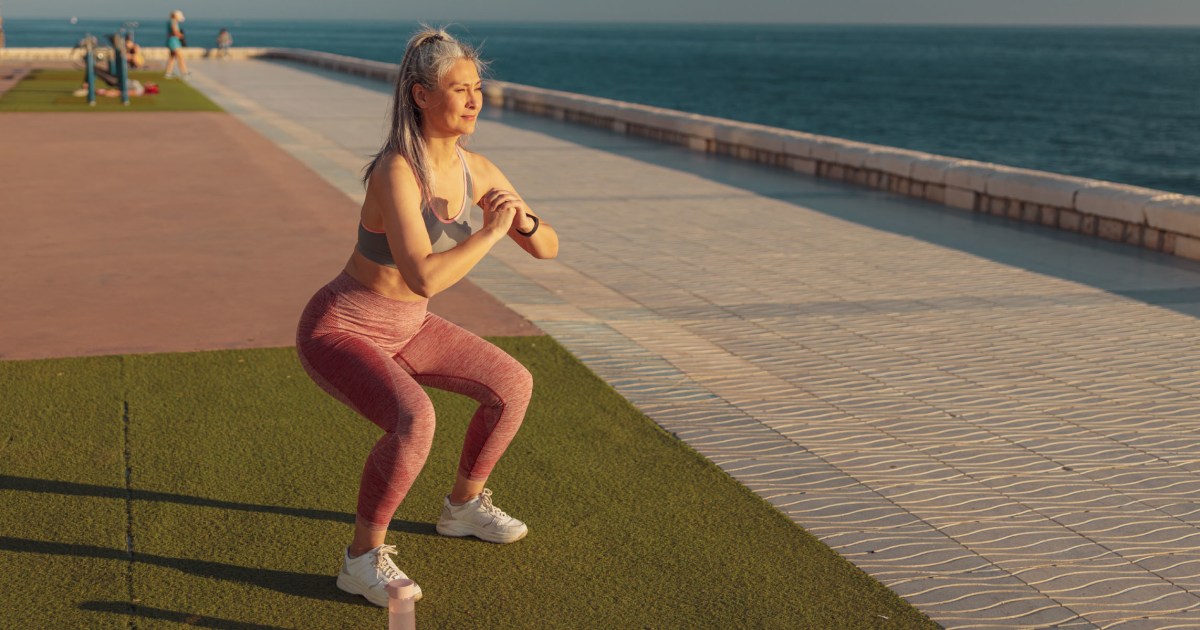
Welcome to Start TODAY. Sign up for our Start TODAY newsletter to receive daily inspiration sent to your inbox — and join us on Instagram!
Coming off a month of fun, Olympic-inspired workouts, we’re going to keep the momentum going with a 31-day walking and full-body strength training challenge.
This plan is designed to provide a balanced approach to exercise, ensuring that all major muscle groups are engaged with basic strength-training exercises that are great for beginners. It’s a fantastic way to boost your fitness level and overall health while building muscle.
The upper-body workouts will focus on building strength in your arms, shoulders, chest and back, while the lower-body exercises will target your legs, glutes and core. By integrating walking into your routine, you will improve cardiovascular health, increase endurance, and enjoy the benefits of low-impact aerobic exercise.
You can also add the strength workouts to any cardio routine you already have in place, so if you’d rather bike, swim, run or take a HIIT class — go for it!
A 31-day walking and strength-training plan for beginners
>>Download a printable calendar here
Each week will feature a mix of targeted strength-training exercises and cardio sessions, helping to create variety in your daily routine. By the end of the month, you’ll not only see physical improvements, but also feel a sense of accomplishment and motivation to continue your fitness journey.
New to Start TODAY? Start by making walking a habit with this 30-day plan.
The benefits of strength training
Many people assume the main reason to incorporate strength training into their routine is to tone the body. While strength training does increase muscle mass that can lead to tighter, toned muscles, it’s far from the only benefit.
Strength-training exercises improve bone density and increase flexibility in the joints. Building strength in your muscles also helps improve balance, speed up the metabolism and burn calories. Muscle mass decreases naturally with age, so as you get older, incorporating strength-training workouts into your regimen becomes even more important. Strength training has also been largely associated with preventing injury.
The health benefits of walking — and why you should mix it up
In addition to strength training, we’ll also continue with our walks to help with cardiovascular health and mobility. This month, I encourage you to up the ante from our typical 20-minute walks and vary your walking times.
Varying the lengths of your walks not only keeps them more interesting and challenging, but also encourages your cardiovascular and muscular system to work in different ways.
Changing it up and keeping your body guessing can help with weight loss (if that’s one of your goals) and improves muscle endurance, stamina and cardiovascular health. Your usual 20 minutes may start to feel easier, and a longer walk may become your new norm, which will burn more calories, speed up your metabolism and improve your circulation.
If walking for 30 or 45 minutes is too much physically, or your schedule doesn’t allow for it, you can break it up throughout the day. Three, ten- or 15-minute bursts is equally as effective as one longer walk. Whether you break it up or do it all in one shot, the point is to increase your time or distance to get in more steps, combat a sedentary lifestyle and speed up your metabolism.
Strength-training routine for beginners
The strength-training plan features five upper-body exercises with dumbbells and five lower-body exercises done using your bodyweight. Perform 10 repetitions of each exercise and then repeat for a total of three rounds. For example, on upper-body days, you’ll do every exercise 10 times, and then once you’ve finished one round, you’ll complete two more rounds.
If you don’t have dumbbells for the upper-body exercises, you can grab water bottles or soup cans. I recommend starting with 3-pound dumbbells, unless you’ve used weights before and feel comfortable with 5- or 7-pound weights. For upper body and core, start with 10 repetitions. Then, to make things more challenging after a couple of weeks, increase to 15 repetitions.
For lower body, I’ve provided modifications for every exercise. If any of the moves bother your knees, stick with the modifications!
Upper body strength workout

Bicep curl
Grab your dumbbells and start with your arms hanging by your sides. Hug your elbows in toward the side of your body, and then curl the weights up toward your shoulders. Slowly lower them back down. Keep pressing the elbows in toward your side, and be careful not to let your arms swing. If your arms are swinging, your weights may be too heavy.
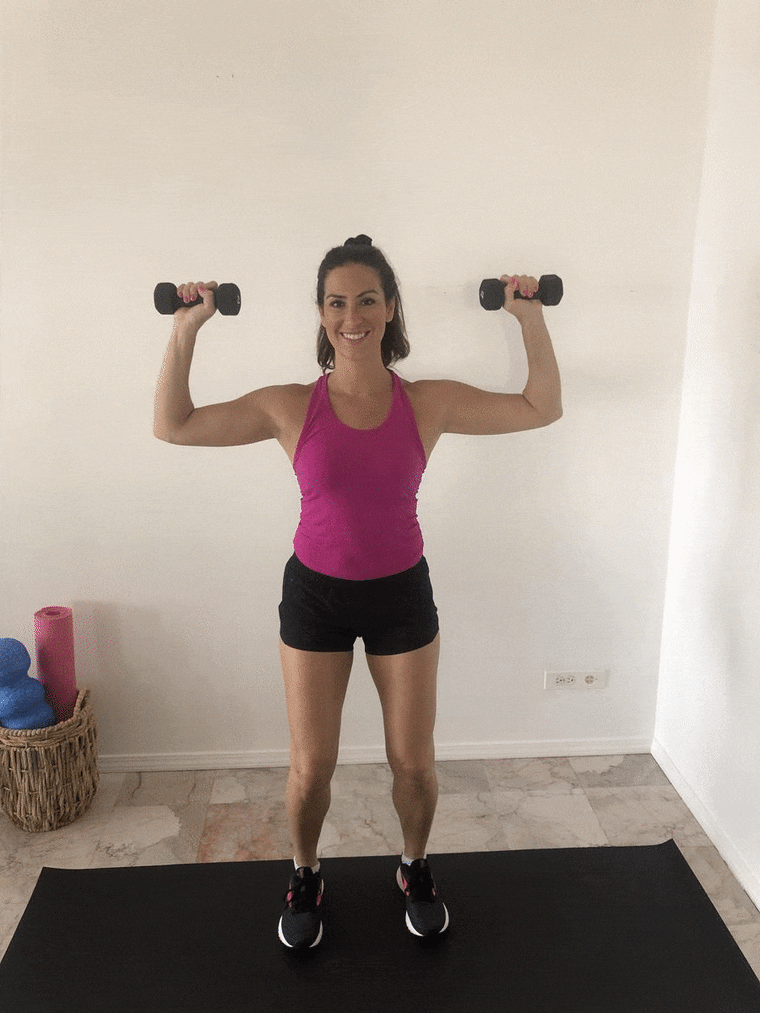
Overhead press
Stand with your feet as wide as the shoulders and hold one dumbbell in each hand. Bring the dumbbells up to a goal post position at shoulder height. Press the weights up toward the ceiling, so that they are slightly in front of your head (just enough so you can see the weights with your eyes without looking up with your neck). Relax the neck and keep your shoulders down away from the ears. Bring the weights back to the goal post position.
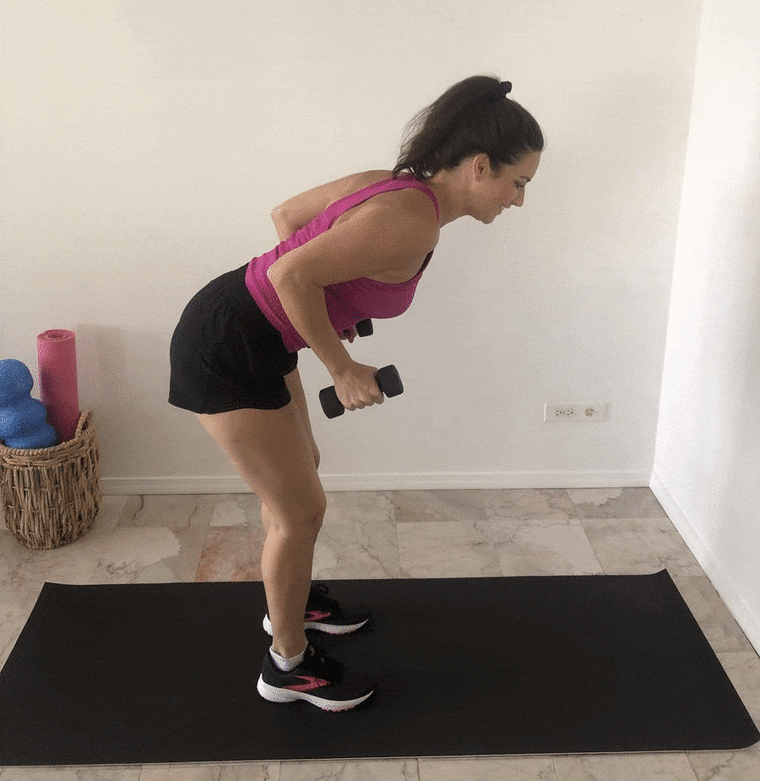
Tricep kickbacks
Holding a weight in each hand, hinge forward at the hips with a flat back. Hug your elbows in toward your sides, and kick the weight toward the back of the room by moving the arm below the elbow only. Feel the back of your arm tighten as you press the arm back, and then release it back to the starting position.
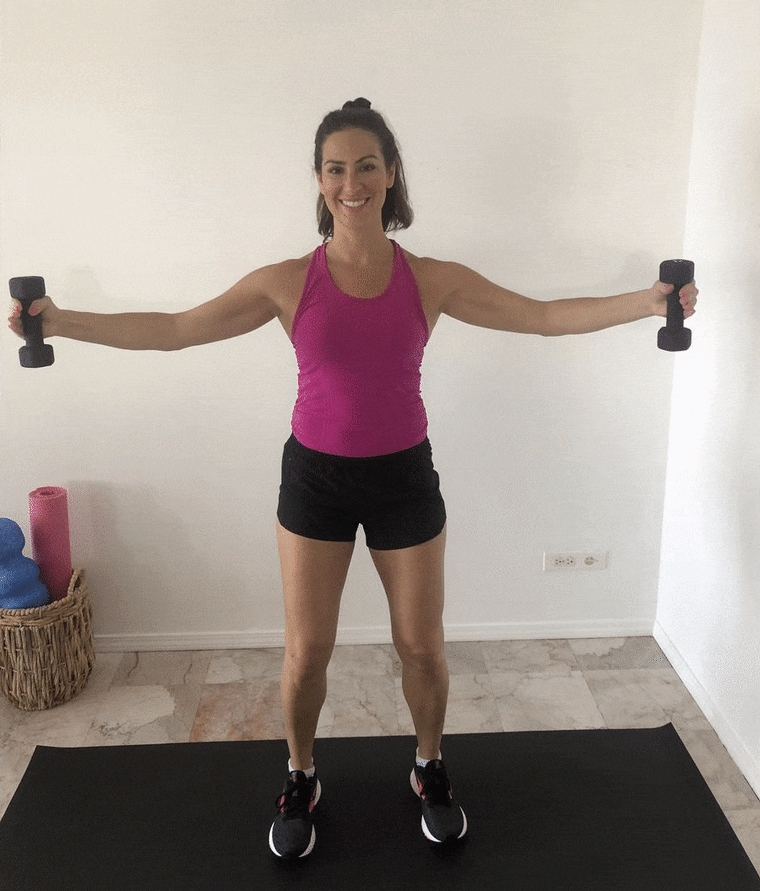
Hug a tree
Hold the weights out to your sides at shoulder height, parallel to the floor. Relax the shoulders down, and then pull the arms toward the front of you as if you’re hugging a tree. Keep the elbows level with your arms — don’t let them dip down — and be conscious of the shoulders starting to raise up. If this happens, it means the weight is too heavy or you’re too fatigued, so you can either perform less reps or decrease the weights.
Serve a platter
Start with your arms at your sides. Bend your elbows at a 90-degree angle so that the weights are out in front of you. Reach the arms straight forward, as if you’re serving a platter, and then pull them back in toward you. Keep the palms facing up the entire time.
Lower-body strength workout
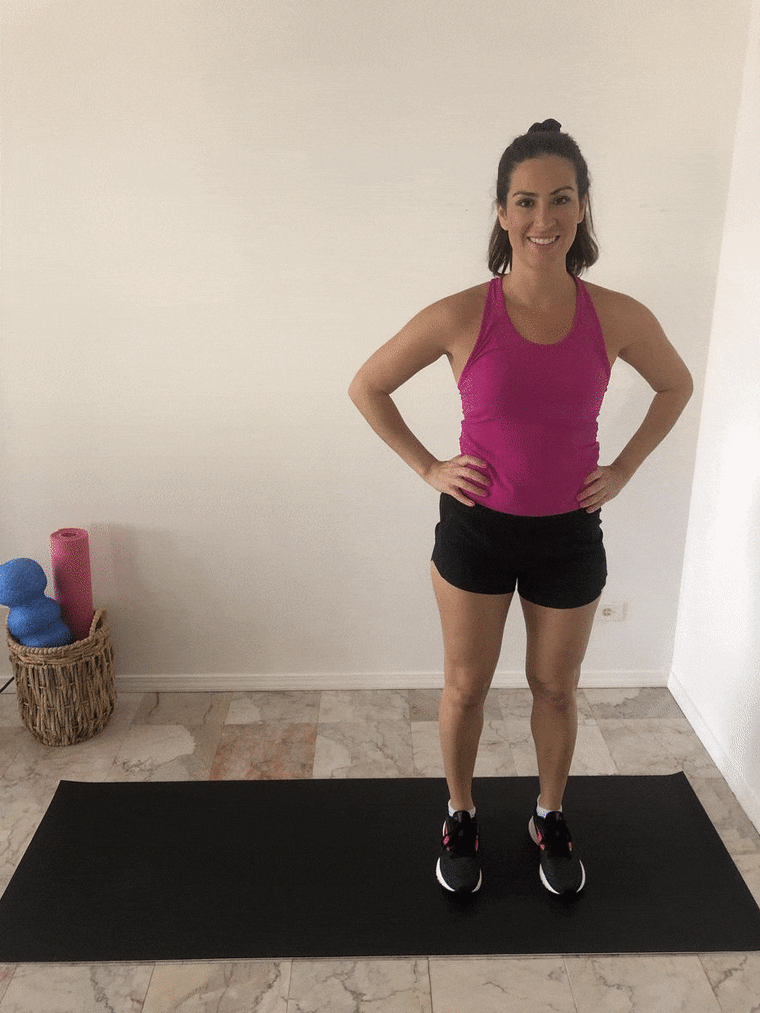
Side lunge
Stand with your feet hip-width apart, and then step your right foot a few feet to the right as you bend the right knee. Keep the left leg straight, and sink back into your right glute. Press down through the right heel to come up to the starting position. Repeat 10 times and then switch sides.
Modification: Standing side leg raises
Stand with your feet hip-width apart and step the right foot to the right so that your toe is resting on the ground and your weight is in the left foot. Point the foot and engage the quad. Lift the leg up as high as the hip, and lower it down. Repeat 10 times, and then switch to the left leg.
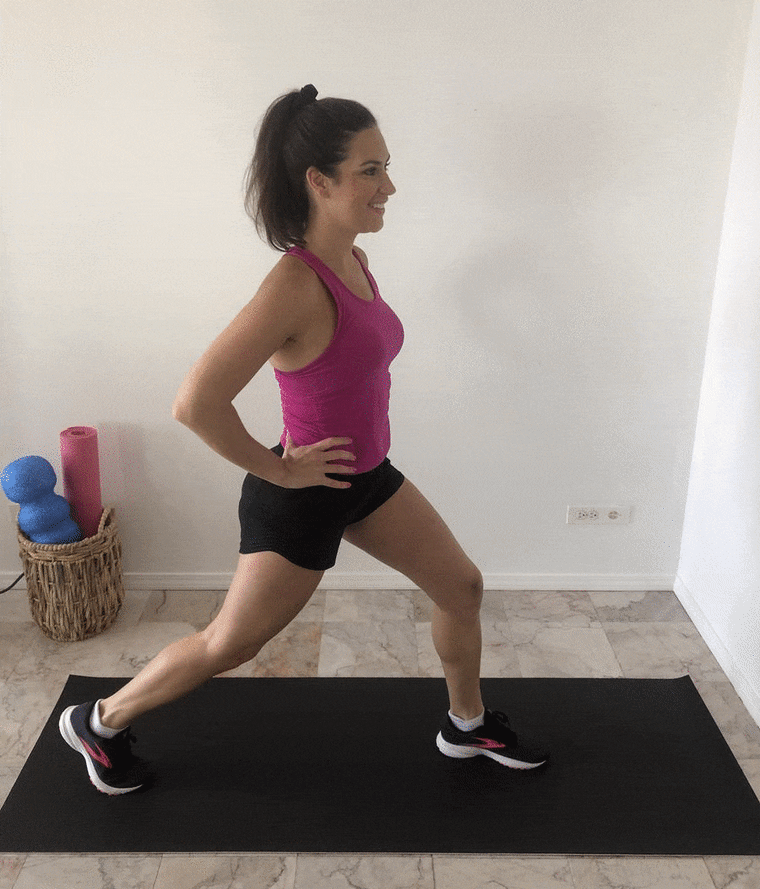
Stationary lunge
Stand with your feet as wide as your hips and your hands on your hips. Step your left foot back a few feet. This is your starting position. Bend the right knee so that it is over the right ankle, and bend your left knee so that the knee reaches down toward the ground. Look in the mirror and make sure your spine stays straight up and down and that you’re not leaning forward. Press down through the front heel to come up to the starting position. Repeat this 10 times then switch sides.
Modification: Standing leg lifts
Stand with your feet hip-width apart. Point your right foot in front of you and squeeze the quad. Lift the leg up almost as high as your hip, and then lower it down. Repeat 10 times and then switch to the left leg.
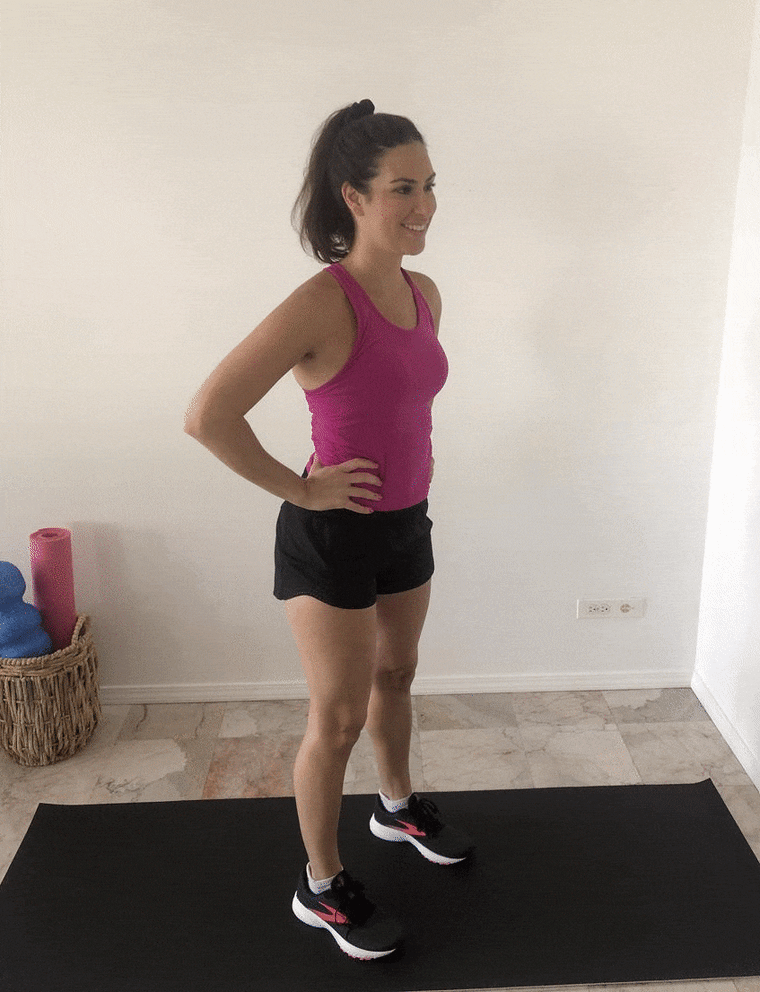
Squat
Begin standing with your feet as wide as the shoulders, toes pointing forward. Bend at the hips and knees while keeping your heels and toes on the floor. Slowly sit back into a squat position with your chest up, your shoulders back and abs in. Make sure that your knees are not crossing over your toes, and that you are as close to a 90-degree angle as possible. Straighten your legs by pressing into your heels to stand back up. Squeeze your glutes at the top, tilting your pelvis forward.
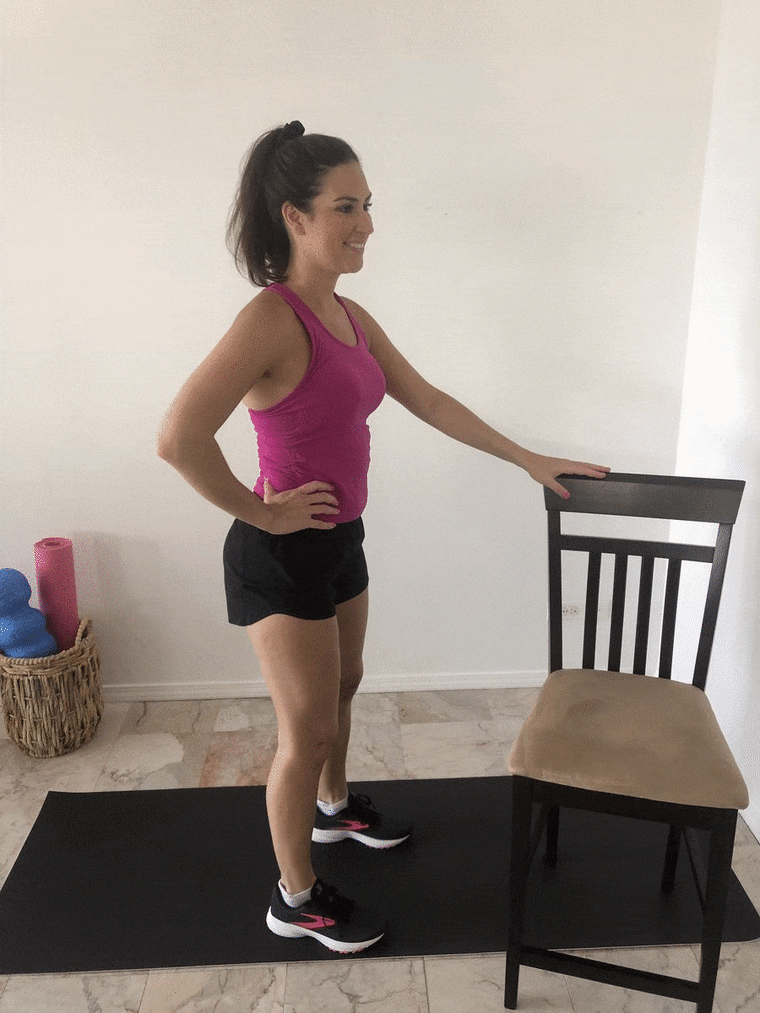
Modification: Modified squat
Holding onto a counter, chair or table with one hand for balance, step the feet out as wide as the shoulders. Sit your glutes back and bend your knees to lower into a half squat. Keep the knees over the toes and pull the abs in. Press down through the heels to stand back up.
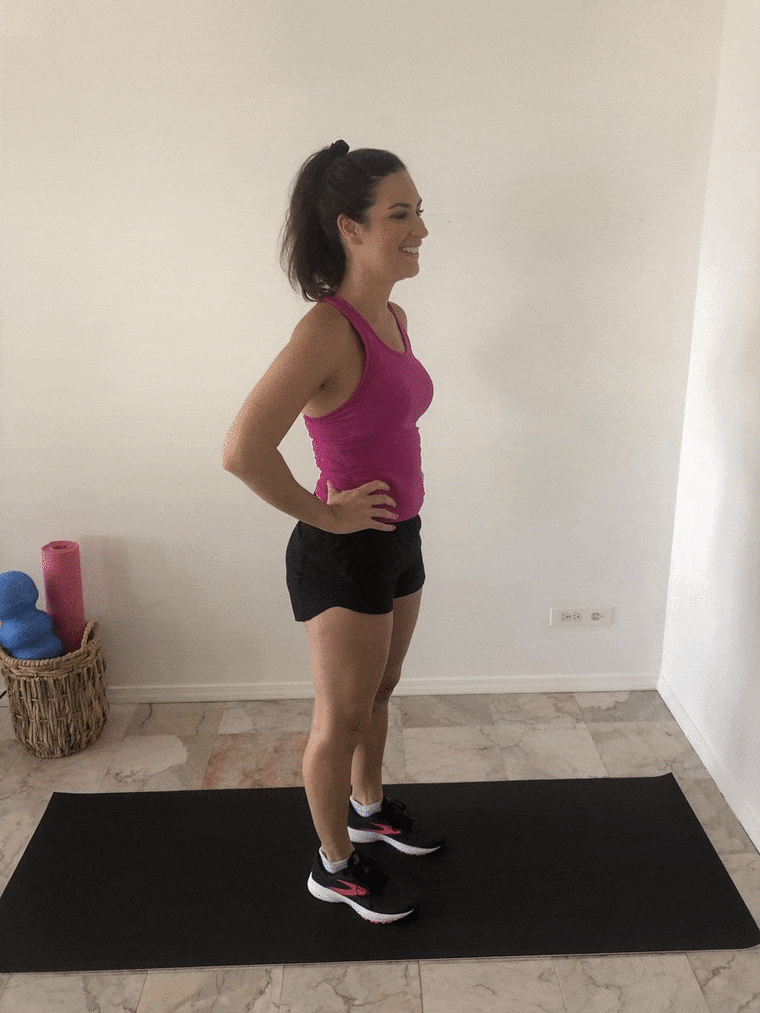
Calf raises (all levels)
Stand with your feet as wide as your hips. Come up onto the toes to lift the heels off of the ground. Then lower the heels down. Repeat 10 times.
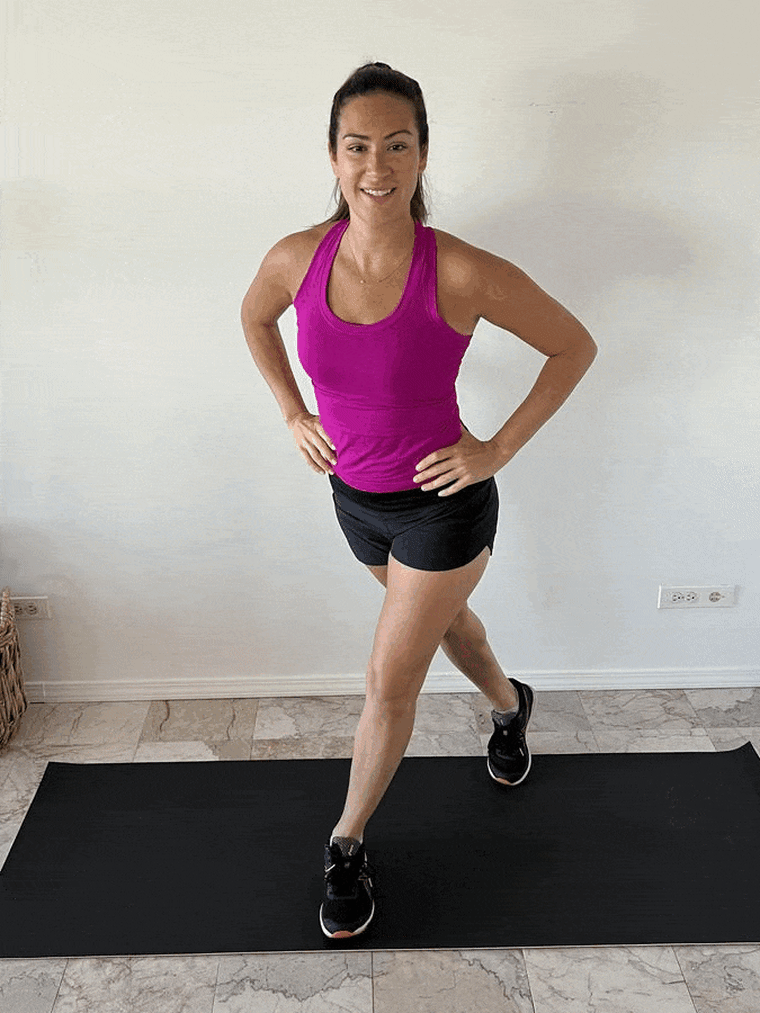
Curtsy lunge
Standing on your feet with your feet as wide as your shoulders, step your right foot back behind your left and to the left of your left foot. Bend both knees as you lower down into a lunge in this curtsy position. Then press down through your left heel to bring your right leg back to center.
Modification: Standing with your feet as wide as your hips, balance on your left foot as you bring the right knee up toward your waist in front of you. Lower the foot down.

Fitness
What Happens to Your Body When You Do Squats, Push-Ups and Crunches Every Day for 30 Days? | BOXROX

Exercise is a fundamental aspect of maintaining a healthy lifestyle. Among various exercises, squats, push-ups, and crunches are classic moves that engage multiple muscle groups and can be performed without any equipment. These exercises have stood the test of time for their effectiveness and simplicity. But what happens if you commit to doing these exercises every day for 30 days?
That is what you are about to find out in the paragraphs below. We talked about how to do the exercises, how to mitigate possible problems, three different scenarios of how your body could change depending on your body fat percentage and training history, and also overall changes to your physical and mental well-being.
Let’s get it on, shall we?
Benefits of Daily Squats, Push-Ups, and Crunches
Enhanced Muscle Strength and Endurance
One of the most immediate and noticeable benefits of performing squats, push-ups, and crunches daily is the increase in muscle strength and endurance.
Squats
Squats primarily target the quadriceps, hamstrings, glutes, and lower back muscles. As you repeatedly perform squats, these muscles adapt by becoming stronger and more resilient. A study published in the Journal of Strength and Conditioning Research found that individuals who performed lower-body resistance exercises like squats experienced significant increases in muscle strength and endurance over time.
Push-Ups
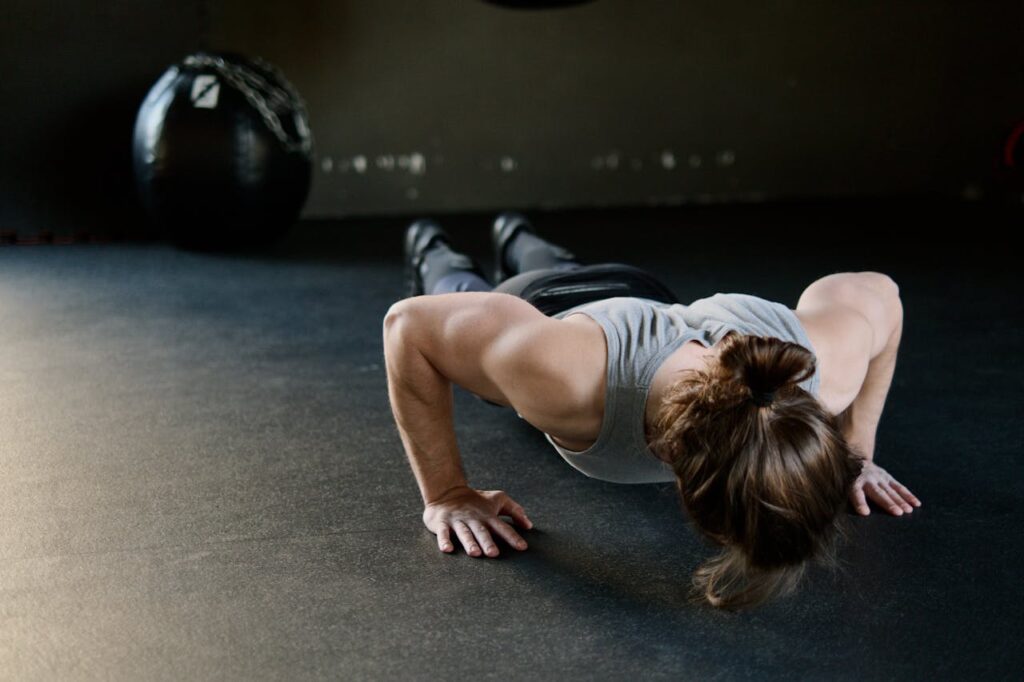
Push-ups are a compound exercise that engages the pectoral muscles, triceps, deltoids, and core. Regularly performing push-ups enhances upper body strength and improves muscular endurance. Research indicates that push-up performance is a reliable indicator of upper body strength and endurance.
Crunches
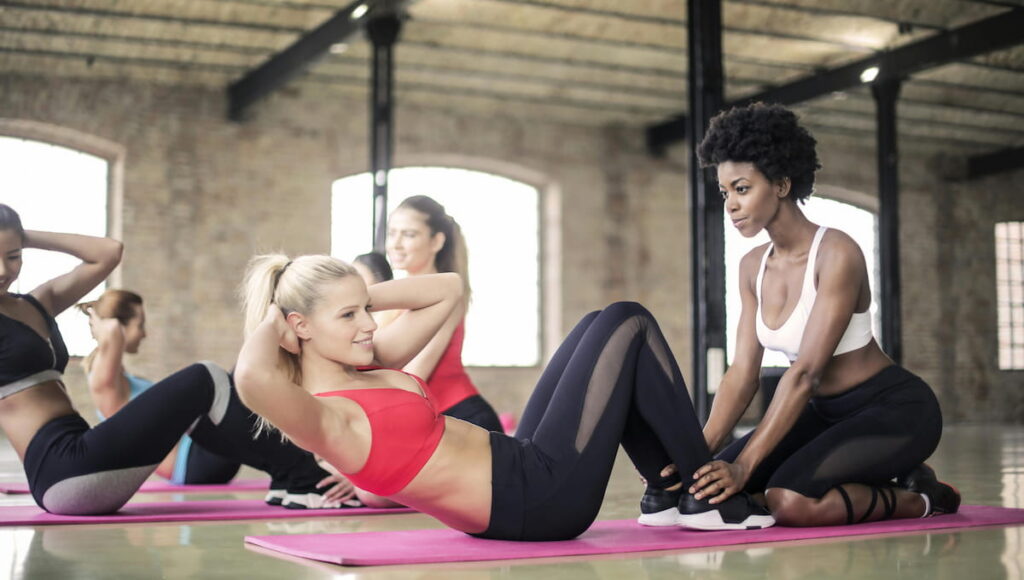
Crunches focus on the abdominal muscles, particularly the rectus abdominis. Daily crunches can lead to stronger and more defined abs. A study in the Journal of Sports Science & Medicine found that regular abdominal exercises contribute to improved core strength and stability.
Improved Cardiovascular Health
While squats, push-ups, and crunches are primarily strength-building exercises, they also offer cardiovascular benefits. Engaging in these exercises increases heart rate and promotes better circulation. The cumulative effect of performing these exercises daily can lead to improved cardiovascular health. The American Heart Association notes that regular physical activity strengthens the heart muscle, improves blood flow, and reduces the risk of cardiovascular diseases.
Enhanced Metabolic Rate and Fat Loss
Regular exercise, including bodyweight exercises like squats, push-ups, and crunches, boosts metabolic rate. This increase in metabolism helps burn calories more efficiently, aiding in weight loss and fat reduction. A study published in the International Journal of Obesity found that resistance training exercises significantly enhance resting metabolic rate and promote fat loss.
Better Posture and Flexibility
Performing squats, push-ups, and crunches daily can also improve posture and flexibility.
Squats
Squats enhance the strength of the muscles that support the spine, which can lead to better posture. Additionally, they improve the flexibility of the hips, knees, and ankles.
Push-Ups
Push-ups help in strengthening the muscles of the upper back, shoulders, and core, all of which are essential for maintaining good posture.
Crunches
Strong abdominal muscles contribute to better posture by supporting the spine and reducing the risk of lower back pain.
Mental Health Benefits
Regular exercise has well-documented benefits for mental health. Engaging in daily physical activity can reduce stress, anxiety, and symptoms of depression. A study in the Journal of Psychiatric Research found that consistent exercise positively affects mood and cognitive function.
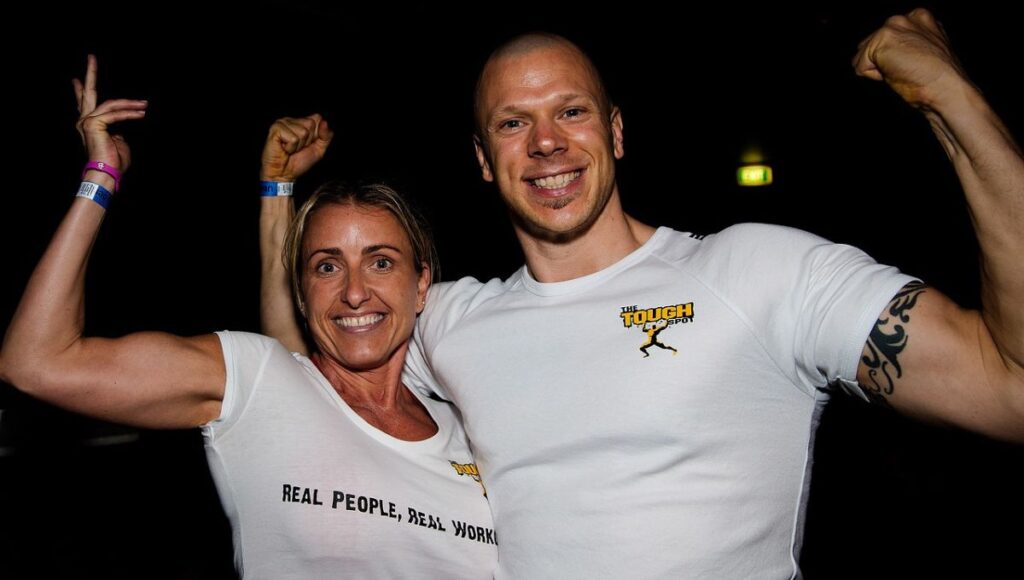
Potential Risks and How to Mitigate Them
While there are numerous benefits to daily exercise, there are also potential risks, especially when exercises are performed incorrectly or without adequate rest.
Overuse Injuries
Performing the same exercises every day without variation can lead to overuse injuries. Overuse injuries occur when the same muscle groups are repeatedly stressed without sufficient recovery time. This can result in muscle strains, joint pain, and tendonitis.
Mitigation Strategies
- Proper Form: Ensuring that you perform each exercise with correct form is crucial. Poor form can lead to unnecessary strain and injury.
- Variation: Incorporating variations of each exercise can prevent overuse injuries. For example, mixing standard squats with sumo squats or adding inclined push-ups can alter the muscle engagement and reduce repetitive strain.
- Rest: Even though the challenge is to perform these exercises daily, incorporating active rest days where you perform lighter versions or fewer repetitions can help with recovery.
Muscle Imbalance
Focusing solely on squats, push-ups, and crunches can lead to muscle imbalances. For instance, while push-ups strengthen the chest and triceps, they might neglect the back muscles if not complemented with pulling exercises.
Mitigation Strategies
- Balanced Routine: Include exercises that target opposing muscle groups. For example, adding rows or pull-ups can balance the muscle engagement.
- Full-Body Workouts: Incorporate full-body workouts that ensure all major muscle groups are exercised.
Plateau Effect
The body can adapt to the same routine over time, leading to a plateau where progress slows down or stops.
Mitigation Strategies
- Progressive Overload: Gradually increasing the intensity, volume, or resistance of the exercises can help overcome plateaus. For example, adding weights or increasing the number of repetitions can challenge the muscles further.
- Mixing Intensity: Alternating between high-intensity and low-intensity days can keep the body guessing and prevent adaptation.
What To Do If Bodyweight Exercises Become Too Easy For You?

Detailed Analysis of Each Exercise
Squats
Technique
- Starting Position: Stand with feet shoulder-width apart, toes slightly turned out.
- Movement: Lower your body by bending your knees and hips, keeping your back straight and chest up. Go down until your thighs are parallel to the floor, then push through your heels to return to the starting position.
- Common Mistakes: Avoid letting your knees collapse inward or your heels lift off the ground.
Variations
- Sumo Squats: Wider stance with toes pointed outward.
- Bulgarian Split Squats: One foot elevated behind you.
- Jump Squats: Adding a jump at the top of the squat.
Push-Ups
Technique
- Starting Position: Hands placed slightly wider than shoulder-width apart, body in a straight line from head to heels.
- Movement: Lower your body until your chest almost touches the floor, then push back up.
- Common Mistakes: Avoid sagging hips or flared elbows.
Variations
- Incline/Decline Push-Ups: Hands on an elevated surface for incline, feet elevated for decline.
- Diamond Push-Ups: Hands close together under your chest.
- Plyometric Push-Ups: Push off the ground explosively.
Crunches
Technique
- Starting Position: Lie on your back with knees bent, feet flat on the floor, hands behind your head.
- Movement: Lift your upper back off the ground, squeezing your abs, then lower back down.
- Common Mistakes: Avoid pulling on your neck or using momentum.
Variations
- Bicycle Crunches: Alternating elbows to opposite knees.
- Reverse Crunches: Lifting hips off the ground.
- Russian Twists: Rotating torso side to side while seated.
How Much Would Your Body Change?

The extent of bodily changes from performing squats, push-ups, and crunches every day for 30 days varies significantly based on individual factors such as initial body composition, fitness level, and consistency in performing the exercises. Here are three possible scenarios with different individuals to illustrate the range of changes one might expect:
Scenario 1: John – Beginner with High Body Fat Percentage (30%)
Profile:
- Age: 35
- Weight: 95 kg
- Body Fat Percentage: 30%
- Fitness Level: Beginner
- Muscle Mass: Low
Expected Changes:
Muscle Development
John will likely experience significant improvements in muscle strength and endurance. Initially, he may find it challenging to complete the exercises, but with consistency, his muscle mass, particularly in the legs, chest, and core, will increase noticeably.
Fat Loss
Due to his high body fat percentage, John can expect substantial fat loss. The combination of increased muscle mass and elevated metabolic rate from daily exercise will help him burn more calories, leading to a reduction in overall body fat. This will result in a more defined appearance, especially in areas where fat was previously more prominent.
Overall Transformation
By the end of 30 days, John may lose a few kilograms of weight, with a more toned and stronger physique. His cardiovascular health will improve, and he will likely notice better stamina and energy levels.
Scenario 2: Sarah – Intermediate with Moderate Body Fat Percentage (20%)
Profile:
- Age: 28
- Weight: 70 kg
- Body Fat Percentage: 20%
- Fitness Level: Intermediate
- Muscle Mass: Moderate
Expected Changes:
Muscle Development
Sarah already has a decent level of fitness and muscle mass. She will see improvements in muscle definition, particularly in the glutes, thighs, chest, and abs. The daily regimen will enhance her muscle endurance, making her stronger and more capable of handling higher-intensity workouts.
Fat Loss
With a moderate body fat percentage, Sarah will experience a modest reduction in body fat, leading to more visible muscle definition. Her waistline might become slimmer, and her abs more pronounced.
Overall Transformation
After 30 days, Sarah will notice a more sculpted body with improved muscle tone and definition. Her overall fitness level will enhance, and she will likely feel stronger and more agile.
Scenario 3: Mark – Advanced with Low Body Fat Percentage (12%)

Profile:
- Age: 25
- Weight: 80 kg
- Body Fat Percentage: 12%
- Fitness Level: Advanced
- Muscle Mass: High
Expected Changes:
Muscle Development
Mark, being advanced, already has significant muscle mass. The daily exercises will primarily serve to maintain his muscle mass and potentially add slight improvements in muscle endurance and definition. He might not see drastic changes in muscle size but will notice a refinement in muscle tone.
Fat Loss
With a low body fat percentage, Mark’s changes in body fat will be minimal. However, he might achieve a slight reduction, making his muscle definition even more pronounced, with a possible increase in vascularity.
Overall Transformation
Mark’s overall transformation will be subtle but noticeable in terms of muscle definition and endurance. He will maintain his high level of fitness and possibly see slight improvements in performance and aesthetics.
Overall Expected Results After 30 Days
Physical Changes
Increased Muscle Mass
Engaging in these exercises daily can lead to hypertrophy, especially in beginners. Muscle fibres grow in response to consistent stress and adaptation.
Improved Definition
As muscles grow and fat is burned, muscle definition improves. This is especially noticeable in the abs, chest, arms, and legs.
Performance Improvements
Strength Gains
Expect significant improvements in strength, particularly in the targeted muscle groups. This is measured by the ease of performing more repetitions or variations of the exercises.
Enhanced Endurance
Performing high-repetition sets daily enhances muscular endurance, allowing you to sustain activity for longer periods without fatigue.
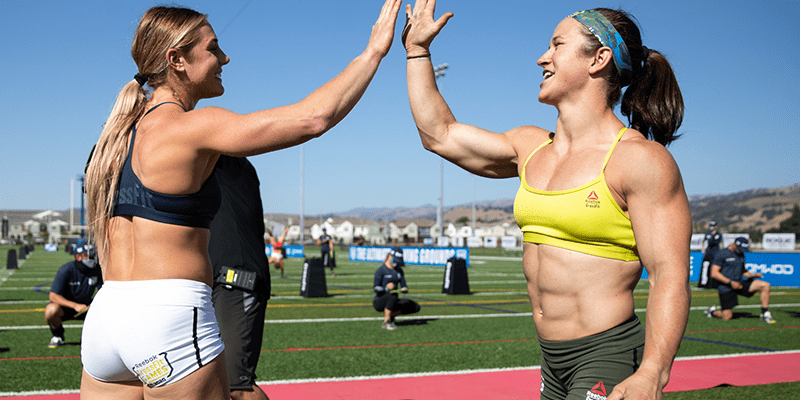
Health Improvements
Better Cardiovascular Health
Increased heart rate and improved circulation from daily exercise contribute to a healthier cardiovascular system.
Enhanced Flexibility and Mobility
Regularly performing these exercises improves joint health and muscle flexibility, reducing the risk of injuries.
Mental Health Benefits
Reduced Stress and Anxiety
Daily physical activity boosts endorphin levels, leading to improved mood and reduced stress and anxiety levels.
Better Sleep
Exercise helps regulate sleep patterns, leading to better quality sleep.
Conclusion
Committing to a regimen of squats, push-ups, and crunches every day for 30 days can lead to substantial physical and mental health benefits. These exercises improve muscle strength and endurance, enhance cardiovascular health, boost metabolic rate, and improve posture and flexibility. However, it’s essential to perform these exercises with proper form and consider incorporating variations and rest to prevent overuse injuries and muscle imbalances. The journey over these 30 days is not just about physical transformation but also about building discipline and improving overall well-being.
Key Takeaways
| Benefit | Description |
|---|---|
| Muscle Strength | Significant increase in muscle strength and endurance, particularly in the legs, upper body, and core. |
| Cardiovascular Health | Improved heart health and circulation from consistent, daily exercise. |
| Metabolic Rate | Enhanced metabolic rate leading to more efficient calorie burning and fat loss. |
| Posture and Flexibility | Better posture and flexibility from strengthened supporting muscles and increased joint mobility. |
| Mental Health | Reduced stress, anxiety, and improved mood through the release of endorphins. |
| Performance Improvements | Increased ability to perform higher repetitions and variations of exercises, indicating improved strength and endurance. |
| Potential Risks | Overuse injuries and muscle imbalances if proper form, variation, and rest are not incorporated. |
References
- Clark, D. R., Lambert, M. I., & Hunter, A. M. (2017). Muscle activation in the loaded free barbell squat: a brief review. Journal of Strength and Conditioning Research, 31(4), 1142-1149.
- Freitas, D. M., et al. (2017). Muscle activity and strength during push-up variations. Journal of Strength and Conditioning Research, 31(12), 3433-3440.
- Willardson, J. M. (2007). Core stability training: applications to sports conditioning programs. Journal of Sports Science & Medicine, 6(1), 40-50.
- American Heart Association. (2018). The benefits of exercise.
- Hunter, G. R., et al. (2015). Resistance training and intra-abdominal adipose tissue in older adults. International Journal of Obesity, 39(2), 292-298.
- Schuch, F. B., et al. (2016). Exercise as a treatment for depression: a meta-analysis adjusting for publication bias. Journal of Psychiatric Research, 77, 42-51.
Was this article helpful?
Fitness
How to become a ‘morning workout’ person – and is it really necessary?

Let’s be honest (and cliched): the best workout is the one you’ll actually do. But if you’re curious about switching to morning sessions for whatever reason – parenting or work duties; making space for your evening social life; you simply can’t be bothered post-work – Women’s Health Collective expert trainer Michelle Griffith-Robinson explains if it’s worth setting those early alarms, and how to make waking up to sweat a bit less of a struggle.
To be clear, you don’t need to become a morning workout person, but there are some benefits.
Benefits of morning workouts
If your blood pressure is above the norm, one study found that 30 minutes of exercise in the morning, followed by frequent breaks from sitting throughout the day, can lower blood pressure for up to eight hours.
Working out in the AM can also help you fall asleep easier, as you’ll kick-start your sleep-wake cycle sooner in the morning, and release melatonin (the hormone that helps you nod off) earlier in the evening. Exercising closer to bedtime will increase heart rate and body temperature, neither of which are conducive to a solid night’s kip. Cortisol levels are higher in the morning, too, and exercise can help regulate them so you feel less stressed throughout the day.
Finally, the endorphins you produce during exercise mean a morning workout can put you in a good mood for the rest of the day. When it comes to getting going, it’s all about discipline. You’ll likely find morning workouts easier during the warmer months, but try to stick with the same routine year-round.
4 tips to become a morning workout person
- Lay out your kit the night before, so that all you have to do is get dressed, and reinforce your routine by scheduling regular sessions so that they become a habit (for example, every Monday and Friday I’m going to train at 7am).
- Making a pact with someone else can also work in your favour, even if you don’t intend on training together –you have them to hold you accountable. A little reward, such as buying a coffee afterwards, or treating yourself to something you’ve been saving up for, can be another great motivator.
- If you’ve tried morning workouts before and struggled, the type of exercise you’re doing could be the problem. Finding a workout you enjoy and look forward to will make getting up so much easier.
- Above all, ensure your chosen time to work out is practical. When can you, realistically, dedicate time to exercise with the least chance of you having to give it a miss? And at what time does exercise make you feel your best? Morning workouts aren’t much use to you if you’re not enjoying them, or they mean you’ll spend the rest of the morning rushed off your feet. Be reasonable with your expectations, and don’t put yourself under too much pressure.
Find a workout that suits you
Cut through the noise and get practical, expert advice, home workouts, easy nutrition and more direct to your inbox. Sign up to the WOMEN’S HEALTH NEWSLETTER

Bridie is Fitness Director at Women’s Health UK. She spends her days sweating over new workouts, fitness launches and the best home gym kit so you have all that you need to get fit done. Her work has been published in Stylist, Glamour, Cosmopolitan and more. She’s also a part-time yoga teacher with a habit of nodding off mid savasana (not when she’s teaching, promise).
Fitness
Should you stretch before exercise? After? Never? Here’s what to know
Panamanian gymnast Hillary Heron stretches as she trains for the Olympics at the No Limits Gymnastics Center in Panama City, Saturday, June 15, 2024, ahead of the Games in Paris.
AP, File
For many people of a certain age, high school gym class began with reaching for their toes. Then, over the years, we were told it was better to stretch after exercise.
It turns out, both those things can be true, but the differing advice has created some confusion.
Stretching can help make you more flexible, improve range of motion in your joints — and feel good. David Behm, who researches human kinetics at Memorial University of Newfoundland in St. John’s, Canada, offers this advice on when to stretch and how to do it safely:
David Behm, author of “The Science and Physiology of Flexibility and Stretching,: Implications and Applications in Sport Performance and Health” stretches.
AP
Warm up first
It’s almost always good to stretch, but it’s better if you warm up first, said Behm, author of “The Science and Physiology of Flexibility and Stretching.” He recommends a light aerobic activity such as jogging, walking or cycling for five or 10 minutes.
Follow that with some static stretching, the traditional way of reaching and holding a position (think back to that gym class). You can then do activity-specific dynamic stretching, in which you warm up the muscles with repetitive movements like leg lifts.
Behm says one minute is “the magic number” for how long to do static stretching per muscle group without fatigue.
The Chicago Cubs mascot playfully stretches with Seiya Suzuki prior to a spring training baseball game against the Los Angeles Angels, Wednesday, March 6, 2024, in Mesa, Ariz.
AP, File
Expand your definition of ‘stretching’
Should you always stretch before exercising? If it’s traditional stretching, not necessarily.
The better question, Behm says, is, “Should people increase their range of motion? Should people have better flexibility? And that is yes, because it helps prevent injuries. It helps with health. But you don’t have to stretch to achieve that.”
Resistance training, for instance, can be an effective form of stretching, he said. Doing a chest press increases range of motion in your deltoids and pecs, whether with barbells, dumbbells or machines, so there is no need to stretch beforehand. Just make sure to start with a small amount of weight to warm up and then add more to train.
“You probably don’t have to do extra stretching unless you’re a gymnast, a figure skater, or even a golfer who needs a great range of motion through that swing,” Behm said.
Nor do you need to stretch first if you’re going for a leisurely run. Simply start with a slow jog to warm up and then increase the pace.
Don’t do it if it hurts
After exercise, “light stretching is OK, as long as you don’t reach a point where you’re feeling pain,” Behm said. Since your muscles will be warm by that point, overdoing it makes you more likely to injure yourself.
Foam rollers can help with muscle recovery and have been shown to increases range of motion as well as stretching.
Do some static stretching before sports
If you’re playing a sport, Behm said, static stretching beforehand helps reduce muscle and tendon injury.
“If you’re going to do an explosive movement, change of direction, agility, sprint, any of these explosive activities that involve your muscles and tendons,” he said, “you’re going to be stronger if you do static stretching.”
People can especially get in trouble when they go back to a sport they used to play, whether it’s tennis, surfing or any sort of team activity.
Also, stretch both sides equally. Lacking flexibility on one side also can lead to injury.
Sounds simple. Why all the confusion?
Different studies over the years have either encouraged or discouraged stretching before exercise. Behm says that partly because some studies didn’t reflect real-life conditions, or were designed with elite athletes in mind, not regular people.
“If you’re Usain Bolt, it makes a difference,” said Behm. Not so much for the rest of us.
-

 Mississippi4 days ago
Mississippi4 days agoMSU, Mississippi Academy of Sciences host summer symposium, USDA’s Tucker honored with Presidential Award
-

 World1 week ago
World1 week agoTyphoon Gaemi barrels towards China’s Fujian after sinking ship off Taiwan
-

 Politics7 days ago
Politics7 days agoRepublicans say Schumer must act on voter proof of citizenship bill if Democrat 'really cares about democracy'
-

 News1 week ago
News1 week agoVideo: Biden Says It’s Time to ‘Pass the Torch’ to a New Generation
-

 News1 week ago
News1 week agoVideo: Kamala Harris May Bring Out Trump’s Harshest Instincts
-

 News1 week ago
News1 week agoWho Can Achieve the American Dream? Race Matters Less Than It Used To.
-
World6 days ago
More right wing with fewer women – a new Parliament compendium
-

 Politics1 week ago
Politics1 week agoHouse unanimously votes to create Trump assassination attempt commission















